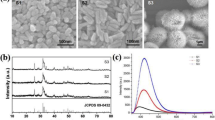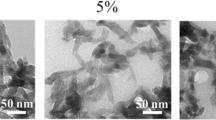Abstract
Nanosized hydroxyapatite (nHA) has been proposed as drug delivery vehicles because of its biocompatibility. While the possible risks of nHA inducing inflammation have been highlighted, the specific influence of varying nHA particle morphology is still unclear. In order to establish this understanding, nHA of four different shapes—needle (nHA-ND), plate (nHA-PL), sphere (nHA-SP) and rod (nHA-RD)—were synthesized. The particle effects with the concentration of 10–300 μg/mL on cytotoxicity, oxygen species generation, production of inflammatory cytokines (TNF-α and IL-6), particle–cell association and cellular uptake were evaluated on BEAS-2B and RAW264.7 cells. Results show that nHA-ND and nHA-PL induced the most significant cell death in BEAS-2B cultures compared to nHA-SP and nHA-RD. Necrosis–apoptosis assay by FITC Annexin V and propidium iodide (PI) staining revealed loss of the majority of BEAS-2B by necrosis. No significant cell death was recorded in RAW264.7 cultures exposed to any of the nHA groups. Correspondingly, no significant differences were observed in TNF-α level for RAW264.7 cells upon incubation with nHA of different shapes. In addition, nHA-RD exhibited a higher degree of particle–cell association and internalization in both BEAS-2B and RAW264.7 cells, compared to nHA-ND. The phenomena suggested that higher particle–cell association and increased cellular uptake of nHA need not result in increased cytotoxicity, indicating the importance of particle shape on cytotoxicity. Specifically, needle- and plate-shaped nHA induced the most significant cell-specific cytotoxicity and IL-6 expression but showed the least particle–cell association. Taken collectively, we demonstrated the shape-dependent effects of nHA on cytotoxicity, inflammatory cytokine expression and particle–cell association.








Similar content being viewed by others
Abbreviations
- nHA:
-
Hydroxyapatite nanoparticle
- HAF:
-
FITC-tagged nHA
- nHA-RD:
-
Rod-shaped nHA
- nHA-DN:
-
Needle-shaped nHA
- nHA-SP:
-
Spherical nHA
- nHA-PL:
-
Plate-shaped nHA
- FITC:
-
Fluorescein isothiocyanate
- ARS:
-
Alizarin red S staining
- DFDA:
-
Dihydrofluorescein diacetate
- ROS:
-
Reactive oxygen species
- APTES:
-
3-Aminopropyltriethoxysilane
- CTAB:
-
Cetyltrimethylammonium bromide
- dsDNA:
-
Double-stranded DNA
- BET:
-
Brunauer–Emmett–Teller
- CPC:
-
Cetylpyridinium chloride
- CLSM:
-
Confocal laser scanning microscopy
- FT-IR:
-
Fourier transform infrared spectra
- XRD:
-
X-ray diffraction
- TEM:
-
Transmission electron microscope
- PI:
-
Propidium iodide
- TNF-α:
-
Tumor necrosis factor
- IL:
-
Interleukin
References
Albrecht C, Scherbart AM, Berlo DV, Braunbarth CM, Schins RPF, Scheel J (2009) Evaluation of cytotoxic effects and oxidative stress with hydroxyapatite dispersions of different physicochemical properties in rat NR8383 cells and primary macrophages. Toxicol In Vitro 23:520–530
Berghe TV, Kalai M, Denecker G, Meenus A, Saelens X, Vandenabeele P (2006) Necrosis is associated with IL-6 production but apoptosis is not. Cell Signal 18:328–335
Bisht S, Bhakta G, Mitra S, Maitra A (2005) pDNA loaded calcium phosphate nanoparticles: highly efficient non-viral vector for gene delivery. Int J Pharm 288:157–168
Cai Y, Liu Y, Yan W, Hu Q, Tao J, Zhang M, Shi Z, Tang R (2007) Role of hydroxyapatite nanoparticle size in bone cell proliferation. J Mater Chem 17(36):3780–3787
Cheng XG, Kuhn L (2007) Chemotherapy drug delivery from calcium phosphate nanoparticles. Int J Nanomedicine 2:667–674
Fan QH, Wang YE, Zhao XX, Loo SCJ, Zuo Y (2011) Adverse biophysical effects of hydroxyapatite nanoparticles on natural pulmonary surfactant. ACS Nano 5(8):6410–6416
Fu Q, Rahaman MN, Zhou N, Huang WH, Wang DP, Zhang LY, Li H (2008) In vitro study on different cell response to spherical hydroxyapatite nanoparticles. J Biomater Appl 23:37–50
Gaiser BK, Fernandes TF, Jepson M, Lead JR, Tyler CR, Stone V (2009) Assessing exposure, uptake and toxicity of silver and cerium dioxide nanoparticles from contaminated enviroments. Environ Health 8(suppl 1):S2
Gorbunoff MJ, Timasheff SN (1984) The interaction of proteins with hydroxyapatite: III. Mechanism. Anal Biochem 136(2):440–445
Goyal AK, Khatri K, Mishra N, Mehta A, Vaidya B, Tiwari S, Paliwal R, Paliwal S, Vyas S (2009) Development of self-assembled nanoceramic carrier construct(s) for vaccine delivery. J Biomater Appl 24(1):65–84
Grandjean-Laquerriere A, Laquerriere P, Laurent-Maquin D, Guenounou M, Phillips TM (2004) The effect of the physical characteristics of hydroxyapatite particles on human monocytes IL-18 production in vitro. Biomaterials 25:5921–5927
Grandjean-Laquerriere A, Laquerriere P, Guenounou M, Laurent-Maquin D, Phillips TM (2005) Importance of the surface area ratio on cytokines production by human monocytes in vitro induced by various hydroxyapatite particles. Biomaterials 26:2361–2369
Hamilton RF, Wu N, Porter D, Buford M, Wolfarth M, Holian A (2009) Particle length-dependent titanium dioxide nanomaterials toxicity and bioactivity. Part Fibre Toxicol 6:35
Han JYL, Loo JSC, Lee J, Ma J (2007) Investigation of the bioactivity and biocompatibility of different glass interface with hydroxyapatite, fluorohydroxyapatite and 58S bioactive glass. BioFactors 30(4):205–216
Han JYL, Loo JSC, Phung NT, Ong HT, Russell SJ, Peng KW, Boey F (2008) Controlled size and morphology of EDTMP-doped hydroxyapatite nanoparticles as model for 153Samarium-EDTMP doping. J Mater Sci Mater Med 19(9):2993–3003
Hans ML, Lowman AM (2002) Biodegradable nanoparticles for drug delivery and targeting. Curr Opin Solid State Mater Sci 6:319–327
Hauck TS, Ghazani AA, Chan WCW (2008) Assessing the effect of surface chemistry on gold nanorod uptake, toxicity and gene expression in mammalian cells. Small 4(1):153–159
Hench LL, Polak JM (2002) Third-generation biomedical materials. Science 295:1014–1017
Heng BC, Zhao X, Tan EC, Khamis N, Assodani A, Xiong S et al (2011) Evaluation of the cytotoxic and inflammatory potential of differentially shaped zinc oxide nanoparticles. Arch Toxicol 85(12):1517–1528
Hsin YH, Chen CF, Huang S, Shih TS, Lai PS, Chueh PJ (2008) The apoptotic effect of nanosilver is mediated by a ROS-and JNK-dependent mechanism involving the mitochondrial pathway in NIHsTS cells. Toxicol Lett 179:130–139
Huang J, Best SM, Bonfield W, Brooks RA, Rushton N, Jayasinghe SN, Edirisinghe MJ (2004) In vitro assessment of the biological response to nano-sized hydroxyapatite. J Mater Sci Mater Med 15:441–445
Kida H, Yoshida M, Hoshino S, Inoue K, Yano Y, Yanagita M, Kumagai T, Osaki T, Tachibana I, Saeki Y (2005) Protective effect of IL-6 on alveolar epithelial cell death induced by hydrogen peroxide. Am J Physiol Lung Cell Mol Physiol 288:L342–L349
Kopf M, Baumann H, Freer G, Freudenberg M, Lamers M, Kishimoto T, Zinkernagel R, Bluethmann H, Koehler G (1994) Impaired immune and acute-phase responses in interleukin-6-deficient mice. Nature 368:339–342
Laquerriere P, Grandjean-Laquerrier A, Jallot E, Balossier G, Frayssinet P, Guenounou M (2003) Importance of hydroxyapatite particles characteristics on cytokines production by human monocytes in vitro. Biomaterials 24:2739–2747
Laquerriere P, Grandjean-Laquerriere A, Addadi-Rebbah S, Jallot E, Laurent-Maquin D, Frayssinet P, Guenounous M (2004) MMP-2, MMP-9 and their inhibitors TIMP-2 and TIMP-1 production by human monocytes in vitro in the presence of different forms of hydroxyapatite particles. Biomaterials 25:2515–2524
Li B, Guo B, Fan H, Zhang X (2008) Preparation of nano-hydroxyapatite particles with different morphology and their response to highly malignant melanoma cell in vitro. Appl Surf Sci 255(2):357–360
Loo J, Siew Y, Ho S, Boey F, Ma J (2008) Synthesis and hydrothermal treatment of nanostructured hydroxyapatite of controllable sizes. J Mater Sci Mater Med 19:1389–1397
Luo D, Saltzman WM (2000) Synthetic DNA delivery systems. Nat Biotechnol 18(1):33–37
Matsumoto T, Okazaki M, Inoue M, Yamaguchi S, Kusunose T, Toyonaga T, Hamada Y, Takahashi J (2004) Hydroxyapatite particles as a controlled release carrier of protein. Biomaterials 25:3807–3812
McFarland-Mancini MM, Funk HM, Paluch AM, Zhou M, Giridhar PV, Mercer CA, Kozma SC, Krew AF (2010) Differences in wound healing in mice with deficiency of IL-6 versus IL-6 receptor. J Immunol 84(12):7219–7228
Motskin M, Wright DM, Muller K, Kyle N, Gard TG, Porter AE, Skepper JN (2009) Hydroxyapatite nano and microparticles: correlation of particle properties with cytotoxicity and biostability. Biomaterials 30:3307–3317
Nan A, Bai X, Son SJ, Lee SB, Ghandehar H (2008) Cellular uptake and cytotoxicity of silica nanotubes. Nano Lett 8(8):2150–2154
Ng SX, Guo J, Ma J, Loo SCJ (2010) Synthesis of high surface area mesostructured calcium phosphate particles. Acta Biomater 6:3772–3781
Ong HT, Loo JSC, Boey FYC, Russell SJ, Ma J, Peng KW (2008) Exploiting the high-affinity phosphonate-hydroxyapatite nanoparticle interaction for delivery of radiation and drugs. J Nanopart Res 10:141–150
Prego C, Garcia M, Torres D, Alonso MJ (2005) Transmucosal macromolecular drug delivery. J Control Release 101(1–3):151–162
Rieux A, Fievez V, Garinot M, Schneider YJ, Préat V (2006) Nanoparticles as potential oral delivery systems of proteins and vaccines: a mechanistic approach. J Control Release 116(1):1–27
Soppimath KS, Aminabhavi TM, Kulkarni AR, Rudzinski WE (2001) Biodegradable polymeric nanoparticles as drug delivery devices. J Control Release 70(1–2):1–20
Stanford CM, Jacobson PA, Eanes ED, Lembke LA, Midura RJ (1995) Rapidly forming Apatitic mineral in an osteoblastic cell line (UMR 106–01 BSP). J Biol Chem 270(16):9420–9428
Unfried K, Albrecht C, Klotz LO, Mikecz AV, Grether-Beck S, Schins RPF (2007) Cellular responses to nanoparticles: target structures and mechanisms. Nanotoxicology 1:52–71
Veis A (2005) A window on biomineralization. Science 307:1419–1420
Victor SP, Kumar TSS (2008) Tailoring calcium-deficient hydroxyapatite nanocarriers for enhanced release of antibiotics. J Biomed Nanotech 4(2):203–209
Xia T, Kovochich M, Brant J, Hotze M, Sempf J, Oberley T, Sioutas C, Yeh JI, Wiesner MR, Nel AE (2006) Comparison of the abilities of ambient and manufactured nanoparticles to induce cellular toxicity according to an oxidative stress paradigm. Nano Lett 6:1794–1807
Xia T, Kovochich M, Liong M, Mädler L, Gilbert B, Shi H, Joanne IY, Zink JZ, Nel AE (2008) Comparison of the mechanism of toxicity of zinc oxide and cerium oxide nanoparticles based on dissolution and oxidative stress properties. ACS Nano 2(10):2121–2134
Zhao X, Heng BC, Xiong S, Guo J, Tan TT, Chiang FBY, Ng KW, Loo JS (2011) In Vitro assessment of cellular responses to rod-shaped hydroxyapatite nanoparticles of varying lengths and surface areas. Nanotoxicology 5(2):182–194
Acknowledgments
The authors wish to thank Nikon Inc. and the SBIC-Nikon Imaging Centre (NIC@SBIC) of Singapore for their assistance in the confocal laser scanning microscopy studies. This work is possible because of the research fund received from the Ministry of Education—AcRF Tier 1 (NTU), and the National Medical Research Council (NMRC) Exploratory/Developmental Grant (EDG) grant (EDG09may011).
Conflict of interest
The authors declare that they have no conflict of interest.
Author information
Authors and Affiliations
Corresponding authors
Electronic supplementary material
Below is the link to the electronic supplementary material.
Rights and permissions
About this article
Cite this article
Zhao, X., Ng, S., Heng, B.C. et al. Cytotoxicity of hydroxyapatite nanoparticles is shape and cell dependent. Arch Toxicol 87, 1037–1052 (2013). https://doi.org/10.1007/s00204-012-0827-1
Received:
Accepted:
Published:
Issue Date:
DOI: https://doi.org/10.1007/s00204-012-0827-1




